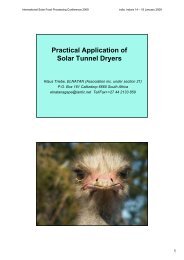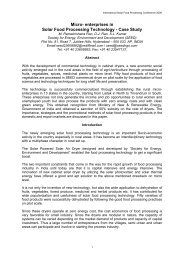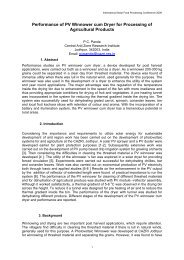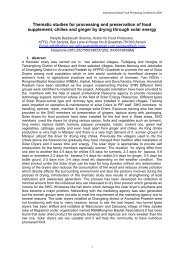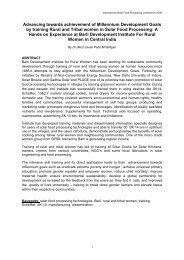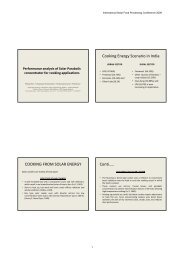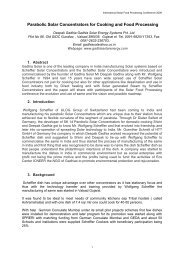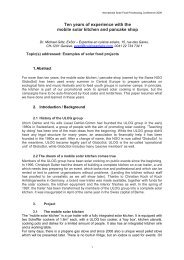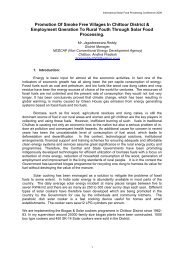Solar drying of fruits, vegetables, spices, medicinal plants and fish ...
Solar drying of fruits, vegetables, spices, medicinal plants and fish ...
Solar drying of fruits, vegetables, spices, medicinal plants and fish ...
You also want an ePaper? Increase the reach of your titles
YUMPU automatically turns print PDFs into web optimized ePapers that Google loves.
International <strong>Solar</strong> Food Processing Conference 2009<br />
<strong>Solar</strong> <strong>drying</strong> <strong>of</strong> <strong>fruits</strong>, <strong>vegetables</strong>, <strong>spices</strong>, <strong>medicinal</strong> <strong>plants</strong> <strong>and</strong> <strong>fish</strong>:<br />
Developments <strong>and</strong> Potentials<br />
B. K. Bala<br />
Department <strong>of</strong> Farm Power <strong>and</strong> Machinery<br />
Bangladesh Agricultural University, Mymensingh-2202, Bangladesh<br />
e-mail: bkbalabau@yahoo.com<br />
Serm Janjai<br />
2<br />
Department <strong>of</strong> Physics, Silpakorn University, Nakhon Pathom, Thail<strong>and</strong><br />
e-mail: serm@su.ac.th<br />
Abstract:<br />
This paper presents developments <strong>and</strong> potentials <strong>of</strong> solar <strong>drying</strong> technologies for <strong>drying</strong> <strong>of</strong><br />
<strong>fruits</strong>, <strong>vegetables</strong>, <strong>spices</strong>, <strong>medicinal</strong> <strong>plants</strong> <strong>and</strong> <strong>fish</strong>. Previous efforts on solar <strong>drying</strong> <strong>of</strong><br />
<strong>fruits</strong>, <strong>vegetables</strong>, <strong>spices</strong>, <strong>medicinal</strong> <strong>plants</strong> <strong>and</strong> <strong>fish</strong> are critically examined. Recent<br />
developments <strong>of</strong> solar dryers such as solar tunnel dryer, improved version <strong>of</strong> solar dryer,<br />
ro<strong>of</strong>-integrated solar dryer <strong>and</strong> greenhouse type solar dryer for <strong>fruits</strong>, <strong>vegetables</strong>, <strong>spices</strong>,<br />
<strong>medicinal</strong> <strong>plants</strong> <strong>and</strong> <strong>fish</strong> are also critically examined in terms <strong>of</strong> <strong>drying</strong> performance <strong>and</strong><br />
product quality, <strong>and</strong> economics in the rural areas <strong>of</strong> the tropics <strong>and</strong> subtropics.<br />
Experimental performances <strong>of</strong> different types <strong>of</strong> solar dryers such as solar tunnel dryer,<br />
improved version <strong>of</strong> solar tunnel dryer, ro<strong>of</strong>-integrated solar dryer <strong>and</strong> greenhouse type<br />
solar dryers which have demonstrated their potentialities for <strong>drying</strong> <strong>fruits</strong>, <strong>vegetables</strong>,<br />
<strong>spices</strong>, <strong>medicinal</strong> <strong>plants</strong> <strong>and</strong> <strong>fish</strong> in the tropics <strong>and</strong> subtropics are addressed.<br />
Simulated performances <strong>of</strong> solar tunnel dryer, improved version <strong>of</strong> solar tunnel dryer <strong>and</strong><br />
ro<strong>of</strong>-integrated solar dryers were assessed for <strong>drying</strong> <strong>fruits</strong>, <strong>vegetables</strong>, <strong>spices</strong>, <strong>medicinal</strong><br />
<strong>plants</strong> <strong>and</strong> <strong>fish</strong>. The agreement between the simulated <strong>and</strong> experimental results was very<br />
good. The simulation models developed can be used to provide design data <strong>and</strong> also for<br />
optimal design <strong>of</strong> the dryer components.<br />
A multilayer neural network approach was used to predict the performance <strong>of</strong> the solar<br />
tunnel drier. Using solar <strong>drying</strong> data <strong>of</strong> jackfruit <strong>and</strong> jackfruit leather, the model was trained<br />
using backpropagation algorithm. The prediction <strong>of</strong> the performance <strong>of</strong> the drier was found<br />
to be excellent after it was adequately trained <strong>and</strong> can be used to predict the potential <strong>of</strong><br />
the drier for different locations <strong>and</strong> can also be used in a predictive optimal control<br />
algorithm. Finally, prospects <strong>of</strong> solar dryers for <strong>drying</strong> <strong>fruits</strong>, <strong>vegetables</strong>, <strong>spices</strong>, <strong>medicinal</strong><br />
<strong>plants</strong> <strong>and</strong> <strong>fish</strong> in the tropics <strong>and</strong> subtropics are discussed.<br />
1. Introduction<br />
Drying is the oldest preservation technique <strong>of</strong> agricultural products <strong>and</strong> it is an energy intensive<br />
process. High prices <strong>and</strong> shortages <strong>of</strong> fossil fuels have increased the emphasis on using<br />
alternative renewable energy resources (Muhlbauer, 1986). Drying <strong>of</strong> agricultural products<br />
using renewable energy such as solar energy is environmental friendly <strong>and</strong> has less<br />
environmental impact.<br />
1
International <strong>Solar</strong> Food Processing Conference 2009<br />
Sun <strong>drying</strong> is still widely used in many tropical <strong>and</strong> subtropical countries. Sun <strong>drying</strong> is the<br />
cheapest method, but the quality <strong>of</strong> the dried products is far below the international st<strong>and</strong>ards.<br />
Improvement <strong>of</strong> product quality <strong>and</strong> reduction <strong>of</strong> losses can only be achieved by the<br />
introduction <strong>of</strong> suitable <strong>drying</strong> technologies. However, increase <strong>of</strong> purchasing power <strong>of</strong> the<br />
farmers <strong>and</strong> the reflection <strong>of</strong> the quality in the price <strong>of</strong> quality dried products are the important<br />
prerequisites for acceptance by the farmers <strong>and</strong> introduction <strong>of</strong> improved <strong>drying</strong> technologies.<br />
As long as there is no or only slight difference in the price for high <strong>and</strong> low quality products, the<br />
additional expenses for new preservation techniques will never be paid back <strong>and</strong> the new<br />
<strong>drying</strong> technologies will not be acceptable by the farmers. However, for adoption <strong>of</strong> the<br />
improved technology field level demonstration <strong>of</strong> the technology <strong>and</strong> advertisement <strong>of</strong> the<br />
quality dried products are essential. Micro-credit may also be needed <strong>and</strong> an extension model<br />
which is also an extension <strong>of</strong> the micro-credit approach <strong>of</strong> Grameen Bank may be adopted.<br />
Furthermore, for sustainability <strong>of</strong> the improved <strong>drying</strong> technology marketing channels must be<br />
established.<br />
<strong>Solar</strong> <strong>drying</strong> can be considered as an elaboration <strong>of</strong> sun <strong>drying</strong> <strong>and</strong> is an efficient system <strong>of</strong><br />
utilizing solar energy (Bala, 1997a & 1998, Zaman <strong>and</strong> Bala, 1989 <strong>and</strong> Muhlbauer, 1986). The<br />
tropics <strong>and</strong> subtropics have abundant solar radiation. Natural convection solar dryers do not<br />
require power from the electrical grid or fossil fuels. Hence the obvious option for <strong>drying</strong> would<br />
be the natural convection solar dryers. Many studies on natural convection solar <strong>drying</strong> <strong>of</strong><br />
agricultural products have been reported (Excell <strong>and</strong> Kornsakoo, 1978, Excell, 1980,<br />
Oosthuizen, 1995, Bala <strong>and</strong> woods, 1994 & 1995, Sharma et al., 1995). Several designs are<br />
available <strong>and</strong> these are (i) cabinet type solar drier suitable for <strong>drying</strong> <strong>fruits</strong> <strong>and</strong> <strong>vegetables</strong><br />
(Sharma et.al, 1995), (ii) indirect natural convection solar drier for paddy <strong>drying</strong> (Oosthuizen,<br />
1995) <strong>and</strong> mixed mode AIT drier for <strong>drying</strong> paddy(Excell, 1978). These dryers have been widely<br />
tested in the tropical <strong>and</strong> subtropical countries. Considerable studies on simulation <strong>and</strong><br />
optimization have also been reported (Bala <strong>and</strong> Woods, 1994&1995 <strong>and</strong> Simate, 2003). The<br />
success achieved by indirect natural convection solar dryers has been limited, the <strong>drying</strong> rates<br />
achieved to date not having been very satisfactory (Oosthuizen, 1996). Box type solar dryer is<br />
suitable for <strong>drying</strong> <strong>of</strong> 10 – 15 kg <strong>of</strong> <strong>fruits</strong> <strong>and</strong> <strong>vegetables</strong> (Sharma et al, 1995). The mixed mode<br />
dryer <strong>and</strong> AIT drier are improvement over the indirect natural convection solar dryer (Bala,<br />
1998). All <strong>of</strong> these types <strong>of</strong> dryers have been tested <strong>and</strong> attempts have been made to extend at<br />
the farm levels. But none <strong>of</strong> these dryers practically exist in the fields in the tropics <strong>and</strong><br />
subtropics. However, Kenya black box dryer which is a mixed mode solar dryer is claimed to be<br />
appropriate for small scale <strong>drying</strong> (Eckert, 1998). Furthermore, these dryers are not suitable for<br />
small scale industrial production <strong>of</strong> <strong>fruits</strong>, <strong>vegetables</strong>, <strong>spices</strong>, <strong>fish</strong> <strong>and</strong> <strong>medicinal</strong> <strong>and</strong> herbal<br />
<strong>plants</strong>. These prompted researchers to develop forced convection solar dryers. These dryers<br />
are (i) solar tunnel drier (Esper <strong>and</strong> Mühlbauer, 1993 <strong>and</strong> Janjai, 2004), (ii) indirect forced<br />
convection solar drier (Oosthuizen, 1996), (iii) Greenhouse type solar drier (Janjai, 2004), (iv)<br />
Ro<strong>of</strong> integrated solar drier (Janjai, 2004) <strong>and</strong> (v) <strong>Solar</strong> assisted dryer (SmitaBhindu, 2004).<br />
Numerous tests in the different regions <strong>of</strong> the tropics <strong>and</strong> subtropics have shown that <strong>fruits</strong>,<br />
<strong>vegetables</strong>, cereals, grain, legumes, oil seeds, <strong>spices</strong>, <strong>fish</strong> <strong>and</strong> even meat can be dried properly<br />
in the solar tunnel dryer (Muhlbauer et al., 1993, El-shiatry et.al, 1991, Schirmer, et.al, 1996,<br />
Esper <strong>and</strong> Muhlbauer, 1993, 1994 & 1996, Bala, 1997b, 1999a&b, 2000 <strong>and</strong> 2004, Bala et.al,<br />
1997, 1999, 2002 & 2003 <strong>and</strong> Bala <strong>and</strong> Mondol 2001).<br />
The purpose <strong>of</strong> this paper is to present the developments <strong>and</strong> potentials <strong>of</strong> solar <strong>drying</strong><br />
technologies for <strong>drying</strong> grains, <strong>fruits</strong>, <strong>vegetables</strong>, <strong>spices</strong>, <strong>medicinal</strong> <strong>plants</strong>, <strong>and</strong> <strong>fish</strong> in the<br />
tropics <strong>and</strong> subtropics <strong>and</strong> the performance <strong>of</strong> the solar driers for <strong>drying</strong> <strong>of</strong> <strong>fruits</strong>, <strong>vegetables</strong>,<br />
<strong>spices</strong>, <strong>medicinal</strong> <strong>plants</strong> <strong>and</strong> <strong>fish</strong> <strong>and</strong> also to present simulated performance <strong>of</strong> the solar tunnel<br />
dryer <strong>and</strong> ro<strong>of</strong>-integrated solar dryer for <strong>drying</strong> <strong>of</strong> chilli <strong>and</strong> neural network prediction <strong>of</strong> the<br />
performance <strong>of</strong> the solar tunnel drier for <strong>drying</strong> <strong>of</strong> jackfruit <strong>and</strong> jackfruit leather<br />
2. <strong>Solar</strong> Drying Systems<br />
2
International <strong>Solar</strong> Food Processing Conference 2009<br />
Different types <strong>of</strong> solar dryers have been designed, developed <strong>and</strong> tested in the different<br />
regions <strong>of</strong> the tropics <strong>and</strong> subtropics. The major two categories <strong>of</strong> the dryers are natural<br />
convection solar dryers <strong>and</strong> forced convection solar dryers. In the natural convection solar<br />
dryers the airflow is established by buoyancy induced airflow while in forced convection solar<br />
dryers the airflow is provided by using fan operated either by electricity/solar module or fossil<br />
fuel. Now the solar dryer designed <strong>and</strong> developed for <strong>and</strong> used in tropics <strong>and</strong> subtropics are<br />
discussed under two headings.<br />
2.1 Natural Convection <strong>Solar</strong> Drying<br />
Natural convection solar <strong>drying</strong> has advantages over forced convection solar <strong>drying</strong> is that it<br />
requires lower investment though it is difficult to control <strong>drying</strong> temperature <strong>and</strong> the <strong>drying</strong> rate<br />
may be limited. Due to low cost <strong>and</strong> simple operation <strong>and</strong> maintenance, natural convection<br />
solar drier appears to be the obvious option <strong>and</strong> popular choice for <strong>drying</strong> <strong>of</strong> agricultural<br />
products. It is the oldest type <strong>of</strong> solar dryer <strong>and</strong> consists <strong>of</strong> a solar collector with a transparent<br />
cover on the top <strong>and</strong> a <strong>drying</strong> unit with an opaque cover on the top. These are connected in<br />
series (Fig. 1.). In such a dryer, the crop is contained within a cabinet in a relatively thin bed,<br />
which completely spans the cabinet. Air, which is heated in a simple flat plate type solar<br />
collector, then flows as a result <strong>of</strong> the buoyancy forces resulting from the temperature<br />
differences up through the crop bed thereby producing the <strong>drying</strong>. The <strong>drying</strong> rates achieved to<br />
date with these dryers have not, generally, been very satisfactory. Oosthuizen (1995) identified<br />
part <strong>of</strong> this failure due to the fact that the dryers have usually not really been matched to the<br />
design requirements. Oosthuizen (1995) also discussed the use <strong>of</strong> a model in the selection <strong>of</strong><br />
a dryer design that meets a particular set <strong>of</strong> requirements. Bala <strong>and</strong> Woods (1994) reported a<br />
mathematical model to simulate the indirect natural convection solar <strong>drying</strong> <strong>of</strong> rough rice <strong>and</strong><br />
Bala <strong>and</strong> Woods (1995) also developed a technique for optimization <strong>of</strong> natural convection solar<br />
dryers.<br />
Fig.1. Indirect natural convection solar dryer<br />
The mixed-mode solar dryer consists <strong>of</strong> a separate solar collector <strong>and</strong> a <strong>drying</strong> unit, both<br />
having a transparent cover on the top. <strong>Solar</strong> radiation is received in the collector as well as in<br />
the dryer box. Exell <strong>and</strong> Kornsakoo (1978) developed a simple mixed mode solar dryer<br />
designed to provide the rice farmer in South-East-Asia with a cheap <strong>and</strong> simple but efficient<br />
method <strong>of</strong> <strong>drying</strong> the wet season harvest. The dryer is shown in Fig. 2 <strong>and</strong> the solar collector<br />
consists <strong>of</strong> a matt-black substance spread on the ground <strong>and</strong> provided with transparent top<br />
<strong>and</strong> side covers. The dryer was initially designed with a bed <strong>of</strong> burnt rice husk as the<br />
3
International <strong>Solar</strong> Food Processing Conference 2009<br />
absorber <strong>and</strong> clear UV stabilized polyethylene plastic sheet as transparent cover. However,<br />
these materials could be substituted with locally available materials such as charcoal, black<br />
plastic or black-painted metal sheets, dark-coloured pebbles, etc.<br />
Many studies have been made to develop mixed solar drier (Exell <strong>and</strong> Kornsakoo, 1978;<br />
Simate 2003). The basic concepts involved in computer modeling <strong>of</strong> such dryers are<br />
discussed by Simate (2003). The computer simulation model is combined with the cost <strong>of</strong> the<br />
drier materials <strong>and</strong> a search technique to find the optimal dimensions <strong>of</strong> such dryers. This<br />
model is based on the concept <strong>of</strong> optimal design <strong>of</strong> solar dryers developed by Bala <strong>and</strong><br />
Woods (1995).<br />
Fig. 2. AIT dryer<br />
2.2 Forced Convection <strong>Solar</strong> Drying<br />
<strong>Solar</strong> tunnel dryer was developed at the University <strong>of</strong> Hohenheim, Germany in the early<br />
eighties for small scale production <strong>of</strong> dried <strong>fruits</strong>, <strong>vegetables</strong>, <strong>spices</strong>, <strong>fish</strong> etc. This type <strong>of</strong> dryer<br />
has been widely tested <strong>and</strong> attained economic viability. A low cost version <strong>of</strong> this drier has<br />
been designed at Bangladesh Agricultural University, Mymensingh, Bangladesh <strong>and</strong> the<br />
pictorial view <strong>of</strong> the dryer under construction is shown in Fig. 3. The drier consists <strong>of</strong> a flat plate<br />
air heating collector, a tunnel <strong>drying</strong> unit <strong>and</strong> a small fan to provide the required air flow over<br />
the product to be dried. These are connected in series as shown in Fig.4. Both the collector<br />
<strong>and</strong> the <strong>drying</strong> unit are covered with UV stabilized plastic sheet. Black paint is used as an<br />
absorber in the collector. The products to be dried are placed in a thin layer in the tunnel drier.<br />
Glass wool is used as insulation material to reduce the heat loss from the drier. The whole<br />
system is placed horizontally on a raised platform. The air at required flow rate is provided by<br />
two dc fans operated by one photovoltaic module. As the air is passed over the product rather<br />
than through the product in the drier, the power requirement to drive a fan is low. To prevent<br />
the entry <strong>of</strong> water inside the drier unit during rain, the cover is fixed like a sloping ro<strong>of</strong>.<br />
4
International <strong>Solar</strong> Food Processing Conference 2009<br />
The design <strong>of</strong> the solar tunnel dryer has been further improved <strong>and</strong> tested by Janjai (2004) at<br />
Silpakorn University at Nakhon Pathom in Thail<strong>and</strong>. The dryer still consists <strong>of</strong> two parts,<br />
namely the solar collector part <strong>and</strong> the <strong>drying</strong> part similar to the original version. Instead <strong>of</strong><br />
using PE plastic sheet, the ro<strong>of</strong> <strong>of</strong> the new design dryer is made <strong>of</strong> polycarbonate plates fixed<br />
with the side walls <strong>of</strong> the dryer. The plate has an inclination angle <strong>of</strong> 5° for the drainage <strong>of</strong> rain.<br />
As loading <strong>of</strong> products to be dried cannot be done from the top <strong>of</strong> the dryer, rectangular<br />
windows were made at the side wall <strong>of</strong> the <strong>drying</strong> part for loading <strong>and</strong> unloading products.<br />
Back insulation was made <strong>of</strong> high density foam s<strong>and</strong>witched between two galvanized metal<br />
sheets. A 15 watt-solar cell module was used to power a dc fan for ventilating the dryer. The<br />
collector part <strong>and</strong> the <strong>drying</strong> part have the area <strong>of</strong> 1.2×4 m 2 <strong>and</strong> 1.2×5 m 2 , respectively. The<br />
schematic diagram <strong>of</strong> this dryer is shown in Fig.5.<br />
Fig. 3. Pictorial view <strong>of</strong> the solar tunnel dryer under construction<br />
5
International <strong>Solar</strong> Food Processing Conference 2009<br />
Fig. 4. <strong>Solar</strong> tunnel drier:<br />
1. air inlet, 2. fan, 3. solar module, 4. solar collector, 5. side metal frame, 6. outlet<br />
<strong>of</strong> the collector, 7. wooden support, 8. plastic net, 9. ro<strong>of</strong> structure for supporting<br />
the plastic cover, 10. base structure for supporting the tunnel drier, 11. rolling<br />
bar, 12. outlet <strong>of</strong> the <strong>drying</strong> tunnel<br />
Fig. 5. Schematic diagram <strong>of</strong> the solar tunnel dryer with polycarbonate cover<br />
A pv-ventilated greenhouse solar dryer was developed at Silpakorn University (Janjai, 2004).<br />
The dryer essentially consists <strong>of</strong> a parabolic shape greenhouse with a black concrete floor with<br />
an area <strong>of</strong> 5.5×8.0 m 2 (Fig. 6.) <strong>and</strong> the pictorial view <strong>of</strong> the dryer is shown in Fig. 7. The<br />
parabolic shape can withst<strong>and</strong> well the tropical rain <strong>and</strong> storm. The ro<strong>of</strong> <strong>of</strong> the dryer is covered<br />
with polycarbonate plates. The floor <strong>of</strong> the dryer is made <strong>of</strong> concrete mixed with black powder<br />
paint to serve as a basement <strong>of</strong> the dryer as well as solar radiation absorber. As concrete has<br />
relatively high heat capacity, it also functions as a heat storage system for the dryer. In<br />
addition, its thermal inertia helps to reduce the variation <strong>of</strong> the <strong>drying</strong> air temperature due to the<br />
fluctuation <strong>of</strong> incident solar radiation. Three fans powered by a solar cell module <strong>of</strong> 53 W are<br />
used to ventilate the dryer during day. Another 53 W solar cell is employed to charge a battery<br />
for night ventilation. This type <strong>of</strong> dryer is developed for village scale use in the tropics <strong>and</strong><br />
subtropics.<br />
6
International <strong>Solar</strong> Food Processing Conference 2009<br />
The loading capacity <strong>of</strong> the pv ventilated greenhouse solar dryer is 100-150 kg <strong>of</strong> fresh chillies.<br />
Drying in the pv ventilated greenhouse results in considerable reduction in <strong>drying</strong> time (50%)<br />
<strong>and</strong> the quality <strong>of</strong> the dry products is high quality dried products in terms <strong>of</strong> color <strong>and</strong> texture.<br />
The payback period <strong>of</strong> the dryer is estimated to be about 3.36 years. This type <strong>of</strong> solar dryer is<br />
suitable for <strong>drying</strong> applications <strong>of</strong> value added products where the quality is reflected in price.<br />
Several units <strong>of</strong> this type <strong>of</strong> dryer have been constructed in Thail<strong>and</strong> <strong>and</strong> are being used for<br />
<strong>drying</strong> <strong>of</strong> chilli, banana <strong>and</strong> green tea.<br />
Fig. 6. Schematic diagram <strong>of</strong> the greenhouse type solar dryer with polycarbonate sheet<br />
The ro<strong>of</strong>-integrated solar dryer consists <strong>of</strong> a ro<strong>of</strong>-integrated solar collector <strong>and</strong> a <strong>drying</strong> bin with<br />
an electric motor operated fan to provide the required air flow (Fig.8.). The bin is connected to<br />
the middle <strong>of</strong> the collector through a T- type air duct connection. The ro<strong>of</strong>-integrated collector<br />
consists <strong>of</strong> two arrays <strong>of</strong> collector: one facing the south <strong>and</strong> other facing the north with a total<br />
area <strong>of</strong> 108 m 2 . These arrays <strong>of</strong> these collectors also serve as the ro<strong>of</strong> <strong>of</strong> the building. The<br />
ro<strong>of</strong>-integrated collector is essentially an insulated black painted ro<strong>of</strong> serving as an absorber<br />
which is covered with a polycarbonate cover.<br />
7
International <strong>Solar</strong> Food Processing Conference 2009<br />
Fig. 7. Pictorial view <strong>of</strong> the greenhouse solar dryer<br />
The <strong>drying</strong> bin is essentially a batch dryer which has a capacity <strong>of</strong> 1.3 × 2.4 × 0.8 m 3 <strong>and</strong> it is<br />
located inside the building. This building was partitioned into 2 rooms <strong>and</strong> a space for placing<br />
the <strong>drying</strong> bin. The first room is used for the preparation <strong>of</strong> the product to be dried <strong>and</strong> the<br />
second for the storage <strong>of</strong> dried products. <strong>Solar</strong> radiation passing through the polycarbonate<br />
cover heats the absorber. Ambient air is sucked through the collectors <strong>and</strong> while passing it<br />
through the collectors gains heat from the absorber. This heated air is passed through the<br />
<strong>drying</strong> bin.<br />
Field level tests <strong>of</strong> <strong>drying</strong> <strong>of</strong> 200 kg <strong>of</strong> rosella flower <strong>and</strong> chilli at Suan Phoeng Educational<br />
Park, Ratchaburi, Thail<strong>and</strong> demonstrated that <strong>drying</strong> in ro<strong>of</strong> integrated solar dryer results<br />
significant reduction in <strong>drying</strong> time compared to the traditional sun <strong>drying</strong> method <strong>and</strong> the dry<br />
product is a quality dry product compared to the quality dry products in the markets. This dryer<br />
was used to dry rosella flower from a moisture content <strong>of</strong> 90% (w.b.) <strong>and</strong> chilli from moisture<br />
content <strong>of</strong> 80% (w.b.) to a moisture content <strong>of</strong> 18% (w.b.) within 3 days. The payback period <strong>of</strong><br />
the ro<strong>of</strong> integrated solar dryer is about 5 years.<br />
Ro<strong>of</strong>-integrated solar dryer is costly in terms <strong>of</strong> capital cost. But the operating cost is extremely<br />
low <strong>and</strong> it is also environment friendly. The ro<strong>of</strong>-integrated solar dryer is suitable for <strong>drying</strong><br />
applications <strong>of</strong> value added products where the quality is reflected in price. Although this dryer<br />
was installed <strong>and</strong> tested for demonstration <strong>of</strong> the <strong>drying</strong> potential <strong>of</strong> herbs <strong>and</strong> <strong>spices</strong>, it is still<br />
being used for production <strong>of</strong> quality dried products for sale to the visitors <strong>of</strong> the Suan Phoeng<br />
Educational Park. After the successful tests <strong>of</strong> this dryer at Suan Phoeng Educational Park,<br />
this type <strong>of</strong> dryer has been constructed at Pakxe provice, Lao’s Democratic Republic. It is now<br />
being used for small scale production <strong>of</strong> quality dried <strong>spices</strong> <strong>and</strong> herbs.<br />
8
International <strong>Solar</strong> Food Processing Conference 2009<br />
Fig. 8. Ro<strong>of</strong> integrated solar dryer<br />
3. Mathematical Modeling<br />
Mathematical models are useful for predicting performance <strong>and</strong> optimal designs <strong>of</strong> solar <strong>drying</strong><br />
systems. The fundamentals <strong>of</strong> heat <strong>and</strong> mass transfer during <strong>drying</strong> are given in Bala (1997a).<br />
The details <strong>of</strong> heat <strong>and</strong> mass transfer during <strong>drying</strong> <strong>of</strong> chilli in a solar tunnel dryer <strong>and</strong> ro<strong>of</strong><br />
integrated solar dryer are given in Hossain (2004) <strong>and</strong> Hossain et al (2005), <strong>and</strong> Janjai et al.<br />
(2006) respectively. Mathematical models to simulate the heat <strong>and</strong> mass transfer in a solar<br />
tunnel drier are discussed below:<br />
Analysis <strong>of</strong> Collector Performance<br />
Considering an element, dx <strong>of</strong> collector at a distance, x from the inlet (Fig. 9.), the energy<br />
balances on the collector components give the following equations (Bala <strong>and</strong> Woods, 1994).<br />
Energy Balances on the Plastic Cover<br />
Energy balance on the cover gives the following equations:<br />
h<br />
( T − T ) + h ( T − T ) + h ( T − T ) − h ( T − T ) = α (1 +τ ρ E (1)<br />
cam c am ca c a rcs c s rpc p c cS cS pS<br />
)<br />
9
International <strong>Solar</strong> Food Processing Conference 2009<br />
E<br />
h rcs<br />
h rpc<br />
h rps<br />
T am<br />
hcam<br />
h ca<br />
Cover<br />
T c<br />
Air out<br />
Air out<br />
Ab. plate<br />
h pa<br />
Tp<br />
x<br />
dx<br />
Fig.9. Heat balances in the flat plate solar collector <strong>of</strong> depth, b<br />
Energy Balances on the Absorber Plate<br />
The following equation gives the energy balance on the absorber plate:<br />
h<br />
pa<br />
( T<br />
p<br />
τ<br />
cSα<br />
pS<br />
E<br />
− Ta<br />
) + hrpc<br />
( Tp<br />
− Tc<br />
) + hrps<br />
( Tp<br />
− Ts<br />
) =<br />
(2)<br />
1−<br />
(1 −α<br />
) ρ<br />
pS<br />
pS<br />
Energy Balances on the Air Stream<br />
The following equation gives the energy balances in the air inside the collector.<br />
bG<br />
a<br />
C<br />
pa<br />
dTa<br />
dx<br />
= h (T − T ) + h (T − T )<br />
(3)<br />
pa<br />
p<br />
a<br />
ca<br />
c<br />
a<br />
Analysis <strong>of</strong> <strong>Solar</strong> Tunnel Drier Performance<br />
The following system <strong>of</strong> equations is developed to describe the <strong>drying</strong> <strong>of</strong> a product in the solar<br />
tunnel drier. Consider an element, dx <strong>of</strong> <strong>drying</strong> tunnel at a distance, x from the inlet <strong>and</strong> the<br />
energy balances in the drier components are shown in Fig. 10.<br />
E<br />
h rcs<br />
h rgc<br />
h rgs<br />
T am<br />
h cam<br />
h ca<br />
Cover<br />
T c<br />
Air out<br />
C h illi b e d<br />
h ga<br />
Air out<br />
T g<br />
Air in<br />
Floor<br />
Air out<br />
x<br />
dx<br />
Fig. 10. Energy balances in the solar tunnel drier <strong>of</strong> depth, b<br />
10
International <strong>Solar</strong> Food Processing Conference 2009<br />
Energy Balances on the Cover<br />
Heat balance on plastic cover <strong>of</strong> <strong>drying</strong> tunnel is same as the cover <strong>of</strong> collector <strong>and</strong> the<br />
temperature <strong>of</strong> plastic cover is<br />
T<br />
c<br />
h<br />
camTam<br />
+ h<br />
caTa<br />
+ h<br />
rcsTs<br />
+ h<br />
rgcTg<br />
+ α<br />
cS<br />
(1 + τcSρgS<br />
)E<br />
= (4)<br />
h + h + h + h<br />
cam<br />
ca<br />
rcs<br />
rgc<br />
Energy Balances on the Product<br />
The following energy balance equation is developed for the <strong>drying</strong> <strong>of</strong> chilli in the solar tunnel<br />
drier.<br />
∂T<br />
∂t<br />
g<br />
⎡<br />
⎢<br />
− ρ<br />
= −<br />
⎣<br />
α<br />
gS<br />
τ<br />
{<br />
1 − (1 − α<br />
cS<br />
gS<br />
g<br />
) ρ<br />
z<br />
g<br />
gS<br />
(C<br />
v<br />
}E + ρ<br />
ρ<br />
∂M<br />
− C<br />
l<br />
) + h<br />
∂t<br />
ρ z (C + C<br />
g<br />
g<br />
z<br />
g<br />
g<br />
z<br />
g<br />
g<br />
(C<br />
L<br />
g<br />
pg<br />
pg<br />
+ h<br />
M )<br />
∂M<br />
+ h<br />
ga<br />
T<br />
∂t<br />
+ C M )<br />
pw<br />
ga<br />
pw<br />
rgc<br />
a<br />
+ h<br />
+ h<br />
rgc<br />
rgs<br />
T<br />
⎤<br />
⎥<br />
T<br />
⎦<br />
c<br />
g<br />
+<br />
+ h<br />
rgs<br />
T<br />
s<br />
(5)<br />
Energy Balances <strong>of</strong> the Air Stream<br />
Change in enthalpy <strong>of</strong> air = heat transferred convectively to the product <strong>and</strong> heat supplied to<br />
air in the evaporated moisture.<br />
∂T<br />
a<br />
∂x<br />
= −<br />
ρ<br />
a<br />
z<br />
( h + h )<br />
a<br />
V<br />
ca<br />
a<br />
(C<br />
pa<br />
ga<br />
T<br />
a<br />
+ C<br />
pv<br />
+<br />
H) ρ<br />
a<br />
z<br />
h<br />
a<br />
ca<br />
V<br />
T<br />
a<br />
c<br />
(C<br />
+ h<br />
pa<br />
ga<br />
T<br />
g<br />
+ C<br />
pv<br />
H)<br />
(6)<br />
Drying Rate Equation<br />
The rate <strong>of</strong> change <strong>of</strong> moisture content <strong>of</strong> a thin layer product inside the dryer can be<br />
expressed by an appropriate thin layer <strong>drying</strong> equation. The Newton equation in differential<br />
form is<br />
dM<br />
dt<br />
= −K( M − M e)<br />
(7)<br />
Mass Balance Equation<br />
The exchange <strong>of</strong> moisture between the product <strong>and</strong> the air inside the dryer is given by<br />
Moisture lost by product = moisture gained by air.<br />
11
International <strong>Solar</strong> Food Processing Conference 2009<br />
∂M<br />
∂H<br />
ρ gdx(<br />
− )dt = bG<br />
a<br />
( )dxdt<br />
(8)<br />
∂t<br />
∂x<br />
Eqs. (1) - (8) are solved using numerical techniques.<br />
Neural Network Computing<br />
An independent multilayer ANN model <strong>of</strong> solar tunnel drier has been developed to represent<br />
the <strong>drying</strong> system <strong>of</strong> jackfruit bulb <strong>and</strong> jackfruit leather (Bala et al. 2005). Network <strong>of</strong> both the<br />
models is 4-layered <strong>and</strong> has large number <strong>of</strong> simple processing elements, called neurons. The<br />
input layer <strong>of</strong> the model consists <strong>of</strong> seven neurons which correspond to the seven input<br />
variables, <strong>and</strong> the output layer has one neuron, which represents the final moisture content<br />
(FMC) in the model (Fig. 11.)<br />
Fig. 11. The structure <strong>of</strong> the ANN solar tunnel dryer model for <strong>drying</strong> jackfruit bulb <strong>and</strong> jackfruit<br />
leather<br />
A wide variety <strong>of</strong> training algorithms has been developed, each with its own strengths <strong>and</strong><br />
weakness. The ANN drier models are trained by backpropagation algorithm so that application<br />
<strong>of</strong> a set <strong>of</strong> input would produce the desired set <strong>of</strong> output. Further details are given in Bala et.al<br />
(2005)<br />
4. Results <strong>and</strong> Discussion<br />
4.1 Experimental results<br />
Large scale field level studies were conducted at Bangladesh Agricultural University,<br />
Mymensingh, Bangladesh <strong>and</strong> Silpakorn University at Nakhon Pathom, Thail<strong>and</strong> to<br />
demonstrate the potentiality <strong>of</strong> the solar driers for production <strong>of</strong> high quality solar dried <strong>fruits</strong>,<br />
<strong>vegetables</strong>, <strong>spices</strong>, <strong>medicinal</strong> <strong>plants</strong> <strong>and</strong> <strong>fish</strong>. Some typical results for solar tunnel dryers,<br />
greenhouse type solar dryer <strong>and</strong> ro<strong>of</strong> integrated solar dryer are summarized below:<br />
Dried mango is an excellent snack food <strong>and</strong> has a dem<strong>and</strong> for both national <strong>and</strong> international<br />
markets. Comparison <strong>of</strong> the moisture contents <strong>of</strong> mango in the solar tunnel drier with those<br />
12
International <strong>Solar</strong> Food Processing Conference 2009<br />
obtained by the traditional method for a typical experimental run during <strong>drying</strong> at Chapai<br />
Nawabganj, Bangladesh is shown in Fig.12. The solar tunnel <strong>drying</strong> required 3 days to dry<br />
mango samples from 78.87% to 13.47% as compared to 78.87% to 22.48% in 3 days.<br />
Moisturecontent, % (wb)<br />
90<br />
80<br />
70<br />
60<br />
50<br />
40<br />
30<br />
20<br />
10<br />
0<br />
Sample<br />
Control<br />
0 1 2 3 4 5 6 7 8 9 10 11 12 13 14 15 16 17 18 19 20 21<br />
Drying time, hr<br />
Fig. 12. Variations <strong>of</strong> moisture content with time for a typical experimental run during solar<br />
<strong>drying</strong> <strong>of</strong> mango.<br />
Dried pineapple is also an excellent snack food <strong>and</strong> has a dem<strong>and</strong> for both national <strong>and</strong><br />
international markets. Comparison <strong>of</strong> the moisture contents <strong>of</strong> pineapple in the solar tunnel<br />
drier with those obtained by the traditional method for the variety Giant Kew for a typical<br />
experimental run during <strong>drying</strong> at Bangladesh Agricultural University, Mymensingh,<br />
Bangladesh is shown in Fig.13. The solar tunnel <strong>drying</strong> required 3 days to dry pineapple<br />
samples from 87.32% to 14.13% as compared to 87.32% to 21.52% in 3 days.<br />
13
International <strong>Solar</strong> Food Processing Conference 2009<br />
Fig. 13. Variations <strong>of</strong> moisture content with time for a typical experimental run during solar<br />
<strong>drying</strong> <strong>of</strong> pineapple.<br />
Mushrooms are edible fungi <strong>of</strong> commercial importance <strong>and</strong> their cultivation <strong>and</strong> consumption<br />
have increased substantially due to their nutritional value, delicacy <strong>and</strong> flavour. But<br />
mushrooms are extremely perishable <strong>and</strong> the shelf life <strong>of</strong> fresh mushroom is only about 24<br />
hrs at ambient conditions <strong>and</strong> 7-10 days even with refrigerated storage because <strong>of</strong> its high<br />
moisture content <strong>and</strong> rich nutrients that spoil easily <strong>and</strong> quickly. Therefore, mushrooms are<br />
usually dried to extend the shelf-life. Hence, these should be consumed or processed<br />
promptly after harvest. Comparison <strong>of</strong> the moisture contents <strong>of</strong> mushroom in the solar tunnel<br />
drier with those obtained by the traditional method for a typical experimental run during<br />
<strong>drying</strong> at Bangladesh Agricultural University at Mymensingh is shown in Fig.14. The moisture<br />
content <strong>of</strong> mushroom reached from 89.41% to 6.14% in 8 hours in the solar tunnel drier <strong>and</strong><br />
it took 8 hours to dry it from 89.41% to 15% in the traditional method under similar conditions.<br />
Fig. 14. Variations <strong>of</strong> moisture content with time for a typical experimental run during solar<br />
<strong>drying</strong> <strong>of</strong> mushroom.<br />
Chilli is an important spice <strong>and</strong> a potential cash crop in the world. It is dried for making powder<br />
<strong>and</strong> to store it for both short term <strong>and</strong> long term storage. Comparison <strong>of</strong> the moisture contents<br />
<strong>of</strong> chilli inside the greenhouse dryer with those obtained by the traditional sun <strong>drying</strong> method<br />
for a typical experimental run conducted at Silpakorn University is shown in Fig. 15. The<br />
moisture contents <strong>of</strong> chilli at three different locations starting from top to bottom inside the dryer<br />
reached to 16.70 % (w.b.), 07.13 % (w.b.) <strong>and</strong> 01.58 % (w.b.) respectively from 76.96 % (w.b.)<br />
14
International <strong>Solar</strong> Food Processing Conference 2009<br />
in 27 hours <strong>of</strong> <strong>drying</strong> in three days while the moisture content <strong>of</strong> a similar sample in the<br />
traditional method after the same period <strong>of</strong> <strong>drying</strong> was 53.78 % (w.b.).<br />
Fig. 15. Comparison <strong>of</strong> the moisture contents <strong>of</strong> chilli inside the greenhouse dryer with the<br />
traditional sun <strong>drying</strong> method for a typical experimental run.<br />
Chilli was also dried in a ro<strong>of</strong> integrated solar dryer at Silpakorn University. For a typical clear<br />
sky weather condition, the moisture content <strong>of</strong> the chilli in the <strong>drying</strong> bin was reduced from an<br />
initial value <strong>of</strong> 80 % (wb) to the final value <strong>of</strong> 18 % (wb) within 3 days or with an effective <strong>drying</strong><br />
time <strong>of</strong> approximately 24 solar hours whereas the moisture content <strong>of</strong> the sun dried samples<br />
was reduced to 53% (wb) during the same <strong>drying</strong> period as shown in Fig. 16. From Fig. 16, it<br />
was observed that the moisture content slowly decreased on the first day <strong>and</strong> it rapidly<br />
decreased on the second day <strong>and</strong> slowly again on the third day while the moisture content <strong>of</strong><br />
control sample decreased very slowly in a similar fashion in the second <strong>and</strong> third <strong>and</strong> the final<br />
moisture content was about 53% (wb).<br />
Moisture content(%,wb)<br />
100<br />
80<br />
60<br />
40<br />
20<br />
0<br />
24/01/2005<br />
solar dryer<br />
Natural sun <strong>drying</strong><br />
25/01/2005 26/01/2005<br />
8:00 11:00 14:00 17:00 8:00 11:00 14:00 17:00 8:00 11:00 14:00<br />
Time (hour)<br />
Fig. 16. Comparison <strong>of</strong> the moisture changes inside ro<strong>of</strong>-integrated solar dryer <strong>and</strong> open<br />
sun <strong>drying</strong> during <strong>drying</strong> <strong>of</strong> chilli<br />
C<strong>of</strong>fee is one <strong>of</strong> the most popular drinks all over the world. C<strong>of</strong>fee beans are needed to dry<br />
immediately after harvest to avoid discoloration because <strong>of</strong> fungi growth. Roasted <strong>and</strong><br />
powdered c<strong>of</strong>fee beans are used for drinking purposes. Among the drinks c<strong>of</strong>fee usually<br />
receives premium for its superior flavor <strong>and</strong> aroma. Fig.17. shows that the moisture content<br />
15
International <strong>Solar</strong> Food Processing Conference 2009<br />
<strong>of</strong> c<strong>of</strong>fee reached to 8.3% from 58.36% (w .b.) in 6 days <strong>of</strong> <strong>drying</strong> in the solar tunnel drier<br />
while it took 6 days to bring down the moisture content in a similar sample to 26.65% in<br />
traditional sun <strong>drying</strong> method.<br />
70<br />
Moisture content, %<br />
60<br />
50<br />
40<br />
30<br />
20<br />
<strong>Solar</strong><br />
Sun<br />
10<br />
0<br />
0 1 2 3 4 5 6 7 8 9 10 11 12 13 14 15 16 17 18 19 20 21 22 23<br />
Time (hours)<br />
Fig.17. Variation <strong>of</strong> moisture content with time <strong>of</strong> day for a typical experimental run during<br />
solar <strong>drying</strong> <strong>of</strong> c<strong>of</strong>fee.<br />
Vasaka (Adhatoda vasica Nees.) is an important <strong>medicinal</strong> plant in the tropics <strong>and</strong> subtropics<br />
<strong>and</strong> it cures cough <strong>and</strong> breathing problem such as asthma. Quality dried vasaka has wide<br />
national market <strong>and</strong> international market for export. The typical <strong>drying</strong> curves <strong>of</strong> vasaka dried in<br />
the solar dryer <strong>and</strong> those dried with natural sun <strong>drying</strong> at Bangladesh Agricultural Research<br />
institute, Gazipur are shown as Fig.18. Blanched vasaka was dried to 3% (wb) from 74% (wb)<br />
in 6 hours in the hybrid solar drier as compared to 12.5% (wb) from 74% (wb) in the traditional<br />
method while non-blanched vasaka was dried to 3% (wb) from 74% (wb) in 8 in the hybrid<br />
solar drier as compared to 16% (wb) from 74% (wb) in the traditional method. In solar dryer, it<br />
took 6 hours to reduce moisture content <strong>of</strong> blanched leaves from 74% (wb) to 3% (wb) but for<br />
non-blanched samples it took 8 hours to reduce similar moisture contents. There is a<br />
significant difference <strong>of</strong> <strong>drying</strong> rate between the blanched <strong>and</strong> non-blanched vasaka as well as<br />
between the <strong>drying</strong> inside the hybrid solar dryer <strong>and</strong> open sun <strong>drying</strong>.<br />
16
International <strong>Solar</strong> Food Processing Conference 2009<br />
Moisture content, %(wb)<br />
80<br />
70<br />
60<br />
50<br />
40<br />
30<br />
20<br />
10<br />
Non-blanched solar <strong>drying</strong><br />
Non-blanched sun <strong>drying</strong><br />
Blanched solar <strong>drying</strong><br />
Blanched sun <strong>drying</strong><br />
0<br />
0 2 4 6 8 10<br />
Drying time, h<br />
Fig. 18. Comparison <strong>of</strong> the moisture changes inside hybrid solar dryer <strong>and</strong> open sun <strong>drying</strong><br />
during <strong>drying</strong> <strong>of</strong> Vasaka leaves<br />
<strong>Solar</strong> tunnel drier has been widely tested in the fields in Bangladesh for <strong>drying</strong> <strong>of</strong> <strong>fish</strong>,<br />
marketing channels have been explored <strong>and</strong> has been introduced with a success. The pictorial<br />
view <strong>of</strong> the dryer is shown in Fig. 19. The typical <strong>drying</strong> curves <strong>of</strong> <strong>fish</strong> dried in the solar tunnel<br />
dryer <strong>and</strong> those dried with natural sun <strong>drying</strong> at Cox’s Bazar, Bangladesh shown are Fig .20.<br />
Drying in the solar tunnel drier required 3 days to dry silver jew <strong>fish</strong> from 71.56% to 14.75% as<br />
compared to 71.56% to 23.63% in 3 days in traditional sun <strong>drying</strong>. There was no difference <strong>of</strong><br />
<strong>drying</strong> rate at different positions <strong>of</strong> solar tunnel dryer.<br />
Fig. 19. Pictorial view <strong>of</strong> the solar tunnel dryer<br />
17
International <strong>Solar</strong> Food Processing Conference 2009<br />
Moisture content, % (wb)<br />
80<br />
70<br />
60<br />
50<br />
40<br />
30<br />
20<br />
10<br />
Sample<br />
Control<br />
0<br />
0 1 2 3 4 5 6 7 8 9 10 11 12 13 14 15 16 17 18 19 20<br />
Drying time, hr<br />
Fig. 20. Variations <strong>of</strong> moisture content with time for a typical experimental run during solar<br />
<strong>drying</strong> <strong>of</strong> silver jew <strong>fish</strong><br />
In all the cases there was a considerable in reduction in <strong>drying</strong> time in solar <strong>drying</strong> using solar<br />
drier in comparison to sun <strong>drying</strong>. The solar dried products were high quality dried products in<br />
terms <strong>of</strong> colour, texture <strong>and</strong> flavour.<br />
4.2 Simulated results<br />
The model was validated against the experimental data <strong>of</strong> chilli. The simulated <strong>and</strong> observed<br />
air temperatures along the length <strong>of</strong> the dryer are shown in Fig. 21. The agreement is good.<br />
Fig. 21. Observed <strong>and</strong> simulated air temperature along the length <strong>of</strong> the dryer<br />
Fig. 22 shows the experimental <strong>and</strong> simulated moisture content during solar <strong>drying</strong> <strong>of</strong> green<br />
chilli in a solar tunnel dryer. Good agreement was found between the experimental <strong>and</strong><br />
simulated moisture contents.<br />
18
International <strong>Solar</strong> Food Processing Conference 2009<br />
800<br />
Moisture content,%(db)<br />
700<br />
600<br />
500<br />
400<br />
300<br />
200<br />
100<br />
1st day<br />
2nd day<br />
Experimental<br />
Simulated<br />
3rd day<br />
0<br />
0 4 8 12 16 20 24<br />
Drying time, h<br />
Fig. 22. Experimental <strong>and</strong> simulated moisture content at the outlet end <strong>of</strong> drier during <strong>drying</strong> <strong>of</strong><br />
green chilli (After Hossain et al 2003)<br />
Fig.23. shows a typical comparison between the predicted <strong>and</strong> experimental values <strong>of</strong> the<br />
temperatures at the outlet <strong>of</strong> the collector during <strong>drying</strong> <strong>of</strong> chilli in a ro<strong>of</strong> integrated solar dryer<br />
at Silpakorn University. The agreement is good. Fig. 24 shows a typical comparison <strong>of</strong> the<br />
predicted <strong>and</strong> observed moisture contents <strong>of</strong> chill inside the dryer <strong>and</strong> the model predicts well<br />
the moisture content changes during <strong>drying</strong>.<br />
Temperature, o C<br />
80<br />
70<br />
60<br />
50<br />
40<br />
30<br />
20<br />
10<br />
0<br />
24/01/05 25/01/05 26/01/05<br />
Experiment<br />
Model<br />
8:00 10:00 12:00 14:00 16:00 8:00 10:00 12:00 14:00 16:00 8:00 10:00 12:00 14:00 16:00<br />
Time (hour)<br />
Fig. 23. Predicted <strong>and</strong> experimental values <strong>of</strong> the outlet temperature <strong>of</strong> the ro<strong>of</strong>-integrated<br />
collector<br />
4.3 Neural network prediction<br />
19
International <strong>Solar</strong> Food Processing Conference 2009<br />
Comparison between the observed <strong>and</strong> neural network prediction <strong>of</strong> the performance <strong>of</strong> solar<br />
tunnel drier for <strong>drying</strong> <strong>of</strong> jack fruit leather is shown in Fig. 25. It is found from Fig. 25 that the<br />
agreement between the predicted <strong>and</strong> observed moisture contents for jackfruit leather is very<br />
good. Thus, if the model is adequately trained, it can appropriately represent the solar tunnel<br />
<strong>drying</strong> system for jack fruit leather <strong>and</strong> can predict the moisture content very well.<br />
Moisture content (kg/kg,wb)<br />
90<br />
80<br />
70<br />
60<br />
50<br />
40<br />
30<br />
20<br />
10<br />
0<br />
Experiment<br />
Model<br />
24/01/05 25/01/05 26/01/05<br />
8:00 11:00 14:00 17:00 8:00 11:00 14:00 17:00 8:00 11:00 14:00<br />
Time (hour)<br />
Fig. 24. Predicted <strong>and</strong> observed values <strong>of</strong> the moisture content <strong>of</strong> chilli<br />
Moisture content, %<br />
90<br />
80<br />
70<br />
60<br />
50<br />
40<br />
30<br />
20<br />
10<br />
0<br />
Prediction<br />
Observation<br />
0 3 6 9 12 15 18<br />
Drying time, hr<br />
Fig. 25. Variation <strong>of</strong> predicted moisture content <strong>and</strong> observed moisture content <strong>of</strong> jackfruit<br />
leather with <strong>drying</strong> time<br />
4.4 Potentials <strong>and</strong> Limitations<br />
Field level tests in Bangladesh <strong>and</strong> Thail<strong>and</strong> have demonstrated the potentialities <strong>of</strong> solar<br />
tunnel dryer, greenhouse type solar dryer <strong>and</strong> ro<strong>of</strong> integrated solar dryer for production <strong>of</strong><br />
quality dried <strong>fruits</strong>, <strong>vegetables</strong>, <strong>spices</strong>, <strong>medicinal</strong> <strong>plants</strong> <strong>and</strong> <strong>fish</strong>.<br />
Different products to be dried have different maximum permissible <strong>drying</strong> air temperatures.<br />
The <strong>drying</strong> air temperature for a product must not exceed the maximum permissible <strong>drying</strong> air<br />
temperature. The maximum permissible temperature for production <strong>of</strong> quality dried pineapple,<br />
mango, jackfruit <strong>and</strong> chilli is 65 °C <strong>and</strong> that <strong>of</strong> <strong>fish</strong> is 52 °C. But for herbal <strong>and</strong> <strong>medicinal</strong> <strong>plants</strong><br />
a maximum temperature <strong>of</strong> 100°C is recommended for glycoside species, 65°C for mucilage<br />
species <strong>and</strong> 35 to 45°C for essential-oil species. This <strong>drying</strong> air temperature can be achieved<br />
20
International <strong>Solar</strong> Food Processing Conference 2009<br />
by simply adjusting collector length (in solar tunnel dryer) or air flow rate by changing the<br />
number <strong>of</strong> fans in operation.<br />
The photovoltaic system has the advantage that the temperature <strong>of</strong> the <strong>drying</strong> air is<br />
automatically controlled by the solar radiation.<br />
<strong>Solar</strong> tunnel drier with UV stabilized plastic cover requires frequent replacement <strong>of</strong> the plastic<br />
cover. However, this problem can be overcome if solar tunnel drier with polycarbonate cover is<br />
used.<br />
In cloudy days the solar tunnel drier can be used for <strong>drying</strong> since it operates on diffuse solar<br />
radiation but the <strong>drying</strong> rate is significantly reduced.<br />
One major disadvantage <strong>of</strong> this drier that it does not have any form <strong>of</strong> back up heating system.<br />
But in rainy days the solar tunnel drier can be used if it is integrated with either a biomass<br />
furnace or oil or gas burner.<br />
The year round operation <strong>of</strong> the solar drier for production <strong>of</strong> different solar dried products would<br />
further reduce pay back period <strong>and</strong> would justify the financial viability <strong>of</strong> the solar drier as an<br />
attractive <strong>and</strong> reliable alternative to the sun <strong>drying</strong> in the tropics <strong>and</strong> subtropics.<br />
Since the drier is PV operated it can be used in the areas where there is no electric grid<br />
connection.<br />
The photovoltaic driven solar drier must be optimized for efficient operation.<strong>Solar</strong> tunnel driers<br />
are now in operation in different regions <strong>of</strong> the tropics <strong>and</strong> subtropics <strong>and</strong> the improved<br />
versions designed by Janjai (2004) are now in operation in the field in Thail<strong>and</strong> <strong>and</strong> Lao’s.<br />
Finally solar driers are environmentally sound.<br />
5. Conclusions<br />
Field level tests demonstrated that pv ventilated solar driers are appropriate for production <strong>of</strong><br />
quality dried <strong>fruits</strong>, <strong>vegetables</strong>, <strong>spices</strong>, herbs <strong>and</strong> <strong>medicinal</strong> <strong>plants</strong>, <strong>and</strong> <strong>fish</strong>.<br />
In all the cases the use <strong>of</strong> solar drier leads to considerable reduction <strong>of</strong> <strong>drying</strong> time in<br />
comparison to sun <strong>drying</strong> <strong>and</strong> the quality <strong>of</strong> the product dried in the solar drier was <strong>of</strong> quality<br />
dried products as compared to sun dried products. However, the <strong>drying</strong> time increases with the<br />
increase in humidity <strong>of</strong> the ambient air.<br />
<strong>Solar</strong> driers are simple in construction <strong>and</strong> can be constructed using locally available materials<br />
by the local craftsman.<br />
The solar drier can be operated by a photovoltaic module independent <strong>of</strong> electrical grid.<br />
The photovoltaic driven solar driers must be optimized for efficient operation.<br />
The neural network prediction <strong>of</strong> the model has been found very good <strong>and</strong> can be used to<br />
predict the potential <strong>of</strong> the drier for different locations <strong>and</strong> can also be used in a predictive<br />
optimal control algorithm.<br />
Nomenclature<br />
C p<br />
specific heat, kJ/kg o K<br />
E solar radiation, W/m 2<br />
G a mass flow rate <strong>of</strong> air, kg/m 2 s<br />
H<br />
humidity ratio, kg/kg<br />
K <strong>drying</strong> constant, min -1<br />
L g latent heat <strong>of</strong> product, kJ/kg<br />
21
International <strong>Solar</strong> Food Processing Conference 2009<br />
M moisture content, % or ratio (db) or (wb)<br />
M e equilibrium moisture content, % or ratio (db) or (wb)<br />
M o initial moisture content, % or ratio (db) or (wb)<br />
T temperature, °C<br />
V<br />
air velocity, m/s<br />
b<br />
depth <strong>of</strong> collector/drier, m<br />
h c convective heat transfer coefficient, W/m 2 o K<br />
h r<br />
radiative heat transfer coefficient, W/m 2 o K<br />
t<br />
time, min<br />
z<br />
thickness, m<br />
Greek<br />
α<br />
ρ<br />
ρ<br />
τ<br />
Subscripts<br />
a<br />
am<br />
c<br />
e<br />
g<br />
l<br />
L<br />
p<br />
s<br />
S<br />
w<br />
v<br />
absorbance<br />
density, kg/m 3<br />
reflectance<br />
transmittance<br />
air<br />
ambient<br />
collector<br />
equilibrium moisture content<br />
product<br />
liquid<br />
long wave<br />
absorber plate<br />
sky<br />
short wave<br />
water<br />
water vapour<br />
References<br />
Bala, B. K. <strong>and</strong> Woods, J. L., Simulation <strong>of</strong> the Indirect Natural Convection <strong>Solar</strong> Drying <strong>of</strong><br />
Rough Rice, <strong>Solar</strong> Energy 53(3), 259-266, 1994.<br />
Bala, B. K. <strong>and</strong> Woods, J. L., Optimization <strong>of</strong> a Natural Convection <strong>Solar</strong> Drying System,<br />
Energy, 20(4), 285-294, 1995.<br />
Bala, B. K., Hossain, M. D. <strong>and</strong> Mondol, M. R. A., Photovoltaic Based Forced Convection <strong>Solar</strong><br />
Tunnel Dryer for Pineapple, Journal <strong>of</strong> Agricultural Engineering, 32(4), 23-31, 1997.<br />
Bala, B. K., Drying <strong>and</strong> Storage <strong>of</strong> Cereal Grains, Oxford & IBH Publishing Co. Pvt. Ltd, India,<br />
1997a.<br />
Bala, B. K., Experimental Investigation <strong>of</strong> the Performance <strong>of</strong> the <strong>Solar</strong> Tunnel Drier for Dying<br />
Fish, Final Research Report, Department <strong>of</strong> Farm Power <strong>and</strong> Machinery, Bangladesh<br />
Agricultural University, Mymensingh, Bangladesh, 1997b.<br />
Bala, B. K., <strong>Solar</strong> Drying Systems: Simulation <strong>and</strong> Optimization, Agrotech Publishing Academy,<br />
India, 1998.<br />
Bala, B. K., Hussain, M. D. <strong>and</strong> Mondol, M. R. A., Experimental Investigation <strong>of</strong> <strong>Solar</strong> Tunnel<br />
Drier for Drying <strong>of</strong> Pineapple, Journal <strong>of</strong> the Institution <strong>of</strong> Engineers, Bangladesh,<br />
Agricultural Engineering Division, 26(4), 37-44, 1999.<br />
Bala, B. K., Adaptive Research on <strong>Solar</strong> Driers for Drying Mango, Pineapple <strong>and</strong> Fish, Annual<br />
Research Report, Department <strong>of</strong> Farm Power <strong>and</strong> Machinery, Bangladesh Agricultural<br />
University, Mymensingh, Bangladesh, 1999a.<br />
22
International <strong>Solar</strong> Food Processing Conference 2009<br />
Bala, B. K., Experimental Investigation <strong>of</strong> the Performance <strong>of</strong> the <strong>Solar</strong> Tunnel Drier for Dying<br />
Cabbage, Banana, Jackfruit <strong>and</strong> Spices, Final Research Report, Department <strong>of</strong> Farm<br />
Power <strong>and</strong> Machinery, Bangladesh Agricultural University, Mymensingh, Bangladesh,<br />
1999b.<br />
Bala, B. K., Adaptive Research on <strong>Solar</strong> Driers for Drying Mango, Pineapple <strong>and</strong> Fish, Annual<br />
Research Report, Department <strong>of</strong> Farm Power <strong>and</strong> Machinery, Bangladesh Agricultural<br />
University, Mymensingh, Bangladesh, 2000.<br />
Bala, B. K. <strong>and</strong> Mondol, M. R. A., Experimental Investigation on <strong>Solar</strong> Drying <strong>of</strong> Fish Using<br />
<strong>Solar</strong> Tunnel Drier, Drying Technology, 19(2), 1-10, 2001.<br />
Bala, B. K., Mondol, M. R. A., <strong>and</strong> Das Choudhury, B. L., <strong>Solar</strong> Drying <strong>of</strong> Mango Using <strong>Solar</strong><br />
Tunnel Drier, Journal <strong>of</strong> Agricultural Engineering, 38(14), 2002.<br />
Bala, B. K., Mondol, M. R. A., Biswas, B. K., Das Choudhury, B. L. <strong>and</strong> Janjai, S., <strong>Solar</strong> Drying<br />
<strong>of</strong> Pineapple Using <strong>Solar</strong> Tunnel Drier, Renewable Energy, 28, 183-190, 2003.<br />
Bala, B. K., Experimental Investigation <strong>of</strong> the Performance <strong>of</strong> the <strong>Solar</strong> Tunnel Drier for Drying<br />
Jackfruit for Production <strong>of</strong> Dried Jackfruit <strong>and</strong> Jackfruit Leather, Annual Research Report,<br />
Department <strong>of</strong> Farm Power <strong>and</strong> Machinery, Bangladesh Agricultural University,<br />
Mymensingh, Bangladesh, 2004.<br />
Bala, B. K., Ashraf, M. A., Uddin, M. A. <strong>and</strong> Janjai, S., Experimental <strong>and</strong> Neural Network<br />
Prediction <strong>of</strong> the Performance <strong>of</strong> a <strong>Solar</strong> Tunnel Drier for Drying Jack Fruit <strong>and</strong> Jack Fruit<br />
Leather, Journal <strong>of</strong> Food Process Engineering, 28, 552-566, 2005.<br />
Eckert, M. van., Mango <strong>drying</strong>: A Tree Product Value, <strong>and</strong> Income Generating Enterprise in<br />
Rural Areas, ITFSP Internal Paper # 19, Nairobi, Kenya, 1998.<br />
El-Shiatry, M. A. Müller, J. <strong>and</strong> Mühlbauer, W., Drying Fruits <strong>and</strong> Vegetables with <strong>Solar</strong> Energy<br />
in Egypt, Agricultural Mechanization in Asia, Africa <strong>and</strong> Latin America, 22(2), 61-64, 1991.<br />
Esper, A. <strong>and</strong> Mühlbauer, W., Development <strong>and</strong> Dissemination <strong>of</strong> <strong>Solar</strong> Tunnel Drier, ISES<br />
<strong>Solar</strong> World Congress, Budapest 22, 1993.<br />
Esper, A. <strong>and</strong> Mühlbauer, W., PV-Driven <strong>Solar</strong> tunnel Drier, Agricultural Engineering<br />
Conference, Bangkok, December 6-9, 1994.<br />
Esper, A. <strong>and</strong> Mühlbauer, W., <strong>Solar</strong> Tunnel Dryer for Fruits, Plant Research <strong>and</strong> Development,<br />
44, 61-80, 1996.<br />
Excell, R. H. B. <strong>and</strong> Kornsakoo, S., A Low Cost <strong>Solar</strong> Rice Dryer, Appropriate Technology,<br />
5(1), 23-24, 1978.<br />
Excell, R. H. B., Basic Design Theory for a Simple <strong>Solar</strong> Rice Dryer, Renewable Energy Review<br />
Journal, 1(2), 1-14, 1980.<br />
Hossain, M. A., Forced Convection <strong>Solar</strong> Drying <strong>of</strong> Chilli, Ph.D. Thesis, Bangladesh Agricultural<br />
University, Mymensingh, 2004.<br />
Hossain, M. A., Bala, B. K. <strong>and</strong> Woods, J. L., Simulation <strong>of</strong> <strong>Solar</strong> Drying <strong>of</strong> Chilli in <strong>Solar</strong> Tunnel<br />
Drier, International Journal <strong>of</strong> Sustainable Energy ; 24: 143-153, 2005.<br />
Janjai,_S., Srisittipokakun, N. <strong>and</strong> Bala, B. K. Experimental <strong>and</strong> modelling performances <strong>of</strong> a<br />
ro<strong>of</strong> integrated solar <strong>drying</strong> system for <strong>drying</strong> herbs <strong>and</strong> <strong>spices</strong>. Energy, 33, 91–103,<br />
2006<br />
Janjai, S., Personal Communication, Silpakorn University, Nakhon Pathom, Thail<strong>and</strong>, 2004.<br />
Mühlbauer, W., Esper, A. <strong>and</strong> Muller, J., <strong>Solar</strong> Energy in Agriculture, ISES <strong>Solar</strong> World<br />
Congress, Budapest, August 23-27, 1993.<br />
Mühlbauer, W., Present Status <strong>of</strong> <strong>Solar</strong> Crop Drying, Energy in Agriculture. 5, 121-137, 1986.<br />
Oosthuizen, P. H., The Design <strong>of</strong> Indirect <strong>Solar</strong> Rice Dryers, Journal <strong>of</strong> Engineering for<br />
International Development, 2(1), 20-27, 1995.<br />
Oosthuizen, P. H., An Experimental Study <strong>of</strong> Simulated Indirect <strong>Solar</strong> Rice Dryer Fitted with a<br />
Small Fan, Journal <strong>of</strong> Engineering for International Development, 3(1), 22-29, 1996.<br />
Simate, I. N., Optimization <strong>of</strong> Mixed Mode <strong>and</strong> Indirect Mode Natural Convection <strong>Solar</strong> Dryers,<br />
Renewable Energy. 28, 435-453, 2003.<br />
Sharma, V. K, Colangelo, A. <strong>and</strong> Spagna, G., Experimental Investigation <strong>of</strong> different <strong>Solar</strong><br />
Driers Suitable for Fruits <strong>and</strong> Vegetable Drying, Renewable Energy, 6(4), 413-424, 1995.<br />
23
International <strong>Solar</strong> Food Processing Conference 2009<br />
Schirmer, P., Janjai, S., Esper, A., Smitabhindu, R. <strong>and</strong> Mühlbauer, W., Experimental<br />
Investigation <strong>of</strong> the Performance <strong>of</strong> the <strong>Solar</strong> Drier for Drying Bananas, Renewable<br />
Energy, 7(2), 119-129, 1996.<br />
Smitabhindu, R., Personal Communication, Royal Chitralada Project, Bangkok, Thail<strong>and</strong>, 2004.<br />
Zaman, M.A. <strong>and</strong> Bala, B.K., Thin Layer <strong>Solar</strong> Drying <strong>of</strong> Rough Rice, <strong>Solar</strong> Energy, 42, 167-<br />
171, 1989.<br />
24



